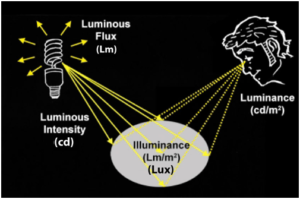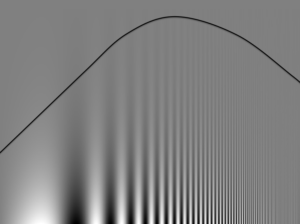Contrast Sensitivity and Measuring Methods
What is contrast?
It is created by the difference in luminance from two adjacent surfaces.
According to Michelson,

According to Weber,

Lmax is the luminance of the light color and Lmin is the luminance of the dark color.

What is Luminance?
Luminance is the Amount of light emitted from a surface per unit area of given direction.

What is Contrast Sensitivity?
- Least amount of contrast required to make a target visible is called Contrast Threshold. Its reciprocal is called Contrast Sensitivity.
- TYPES:
- Spatial CS- is given by stationary striped patterns or letters(Most of the times we measure only spatial CS)
- Temporal CS- is given by gratings that reverse contrast at various rates over time. It is a time-related processing
What are the units of contrast sensitivity?
- Contrast sensitivity is measured in terms of cycles /degree
- Cycles / degree is the unit of spatial frequency Ex:30 cycles/degree (30 bars & gaps in 1 degree)
- The space between any 2 bars in a grating is specified in terms of spatial frequencies.
- The measure of how often sinusoidal components of the structure repeat per unit of distance.
- Variation of luminance across a scene can be described as a series of sine waves of different spatial frequencies.

How is it tested?
It is tested using either sine wave or square wave gratings
- Sine wave grating: Gradual change in contrast
- Square wave grating: Sudden change in contrast


Charts used for Contrast sensitivity:
| Gratings Chart | Letters Chart |
| FACT (Functional acuity contrast test) | Pelli Robson letter chart |
| Arden plates | The Bailey lovie chart |
| Vistech chart | Regan’s Low contrast chart |
| The melobourna edge test | |
| Cambridge low contrast grating | |
| Vector vision csv-1000 | |
| Monitor B-VAT II and B –VAT II SG: |
Among these, Pelli Robson chart is most widely used.
- This chart consists of Snellen letters of the same size with contrast high to low
- Contrast levels-100% to 0.56%
- 8 lines printed on cardboard of size 86×63 cm
- 6 letters on each line
- The spatial frequency of each letter -1.25 cpd
- Each group of 3 letters on each line has 0.15 log units contrast more than the next letter
- Test distance – 1 meter
- External illumination -85 cd/m2
- Spectacle correction should be worn by the patient
- Occlude other eye, do it monocularly and then binocularly
- Ask the patient to read the lowest letters they can see and encourage him to keep looking at the line for 20 seconds.
- Score each letter
- RECORDINGS:
Pelli robson
RE:1.70 log CS
LE: 1.75 log CS
BE-1.85 log CS
How do you interpret?
These are the normal Contrast sensitivity values
- If the subject age is between 20-50: monocular cs should be 1.80 log CS units,
- If the age is <20 and > 50: monocular cs should be 1.65 log CS units, If monocular values are equal binocular should be 0.05 log units more than monocular value.
What are the factors which affect contrast sensitivity?
- Luminance
- Target size
- Grating motion
- Grating shape
- Pupil size
- Refractive error
- Opacities
How do we perceive contrast sensitivity?
- Ganglion cells have antagonistic centre (centre excitatory and surrounding inhibitory or centre inhibitory and surrounding excitatory) surround organization
- The part of the ganglion cell which receives stimuli is called the receptive field. The size of the receptive field varies among the ganglion cells.
- Receptive fields respond to ratios of luminance(the difference in luminance between the colours) instead of absolute luminance(original luminance)
How much contrast can we perceive?
- The human visual system is most sensitive in detecting contrast differences occurring at 4 -6 cycles per degree which means we have receptive fields for the spatial frequency of 4 -6 cycles per degree.
- The high-frequency cut-off: Stimuli smaller than the centre receptive field only produces a partial response from the ganglion cells due to the optical limitations of the visual system’s ability to resolve detail.
- The low-frequency drop-off: Stimuli larger than the centre receptive field also stimulate the surrounding area so that the overall response from ganglion cell is reduced due to lateral inhibition within the retinal ganglion cells
What is CSF(Contrast sensitivity function)?
- The manner in which contrast sensitivity changes as a function of the spatial frequency of the target.


What is contrast sensitivity curve?
The graph which shows the relation between the Contrast sensitivity and visual acuity is called contrast sensitivity curve.


Where is it used?
- Early detection of ocular conditions-Glaucoma, multiple sclerosis, minimum capsular opacification, ocular hypertension, astigmatism, keratoconus
- Assists in more precise assessments of patients before surgery and post-operatively- Cataract, refractive surgery
- Monitoring disease – Amblyopia, diabetes, optic neuritis and papilledema
What are the symptoms of low contrast sensitivity?
- Problem while Night driving
- Needs extra light to perform their works
- Eyes become tired easily
- Not being able to find out spots on clothes and plane surfaces
- Missing facial gestures
References:
http://www.elsevier.ca/ISBN/9780702051944/Clinical-Procedures-in-Primary-Eye-Care
http://www.goodreads.com/book/show/5481516-optometry
http://redwood.psych.cornell.edu/discussion/papers/bkgnd_dc.pdf accessed on 14 th Aug 2016
http://webvision.med.utah.edu/book/part-ii-anatomy-and-physiology-of-the-retina/ganglion-cell-physiology/ accessed on 14 th Aug 2016



